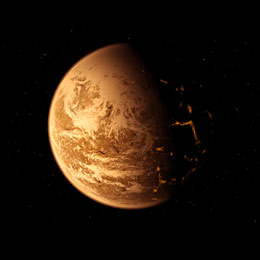
An artist's concept of the seven-Earth-mass planet closely orbiting the red-dwarf star Gliese 876. In reality, the planet might have no atmosphere (like a giant Mercury), a thin atmosphere allowing a view of the surface as shown here, or a very thick atmosphere almost like Uranus or Neptune. Such a massive world, if rocky, could have strong plate tectonics as suggested by the lines of volcanism depicted here on the night side.
Trent Schindler / NSF
After three years of maintaining secrecy while collecting more and more evidence, a team of astronomers today announced finding an entirely new type of planet orbiting a dim star 15 light-years away. The object is the lightest known extrasolar planet orbiting a normal star, with a mass between 6 and 9 Earths and most likely 7½ Earth masses. At a National Science Foundation press conference this afternoon, Geoffrey W. Marcy (University of California, Berkeley), R. Paul Butler (Carnegie Institution of Washington), and four colleagues called their find the most Earthlike world yet discovered outside our solar system.
While that is technically true, the planet is truly weird by any Earthly standard.
The new world orbits the red-dwarf star Gliese 876 at a distance of only 2 million miles (3.2 million kilometers, or 0.021 astronomical unit) with an orbital period — a "year" — that is only 46 hours long. It's so close to its little star that the star must appear in its sky as a fireball 12° across — some 24 times as wide as the Sun in Earth's sky, or about the size of a tennis ball held at arm's length.
As a result, the planet's temperature should be some 200° to 400° Celsius (400° to 750° Fahrenheit), well above the boiling point of water at Earth's atmospheric pressure but perhaps below the boiling point of water if the world has a thick enough atmosphere, barring a strong greenhouse effect. Whether it has an atmosphere at all is unknown. It could consist of bare rock, rock swathed in an atmosphere as thick as Earth's or Venus's, or it could be a Uranus analog, a hot "ice giant" in which a massive atmosphere rich in cosmic volatiles (water, methane, ammonia) comprises a fair fraction of the objects's entire bulk. If the world is rocky it would be about 1.75 times Earth's diameter, and its strong surface gravity (about 2.5 times Earth's) would probably keep its topography relatively flat.
Like nearly all extrasolar planets, Gliese 876d, as it's named, was found by the Doppler-shift wobble that its gravity induces in the radial velocity of its host star. Nor is it the first planet found this way orbiting Gliese 876. The star (glowing at 10th magnitude in Aquarius, with spectral type M4 and 1/3 the mass of the Sun) was already known to possess two much heftier planets. These are "warm Jupiters" with 2.5 and 0.8 Jupiter masses (about 800 and 250 Earth masses), revolving around the star at greater distances about every 60 and 30 days, respectively.
These two giants are locked into a 2:1 orbital resonance, slowly drifting back and forth around this perfect matchup (see the January Sky & Telescope, page 44). Intense data-gathering to understand this interesting system, and analysis intended to study the resonance and the two planets' gravitational effects on each other, were what led Eugenio J. Rivera (UC Santa Cruz) to detect the very slight Doppler signature of the third planet buried in the complicated motions.
The team, proud of its perfect record of announcing 107 planets without ever having to retract one in light of further data, waited until it had enough radial-velocity measurements to make the case "rock-solid, even though the planet may not be solid rock," quipped team member Jack Lissauer (NASA/Ames Research Center) at the press conference. The team has submitted its paper to the Astrophysical Journal.
"We consider this the most exciting of the 107 planets we've discovered," said Marcy. "It resides in a mass domain that is completely uncharted in our solar system." Gliese 876d has about half the mass of the previous record lightweights for normal stars; those are approximate matches for Neptune.
The discovery overshadowed another first that the astronomers announced at the press conference. By measuring the gravitational effects of the star's two Jupiters on each other (as revealed by mutual perturbations in their orbits), Rivera was able to determine their true masses and thus the inclination of their orbits to the plane of the sky: about 50°. In most systems studied by radial-velocity wobbles, the unknown inclination means that the measured masses are only lower limits, though probably not much lower than the true masses. The value of 7½ Earths for the new object assumes that it lies in the same plane as the two giants, solar-system style.
In addition, the team announced that it is now sometimes achieving precisions of just 1 meter per second in its measures of stellar radial velocities, compared to about 3 meters per second previously. This may mean that planets even down to the mass of Earth itself could become detectable around small stars. Said Lissauer, "The planet we're announcing today is probably the most Earthlike to be discovered since the dawn of history. But it's not likely to hold that title for long."
More about the discovery is in the NSF press release.
The star itself is in easy reach of amateur telescopes. Using a detailed, large-scale star atlas, you can find it glowing orange at right ascension 22h 53m 13s, declination –14° 15' 13" (2000.0 coordinates). It's in the bottom of Aquarius's water bucket, as Sky & Telescope
draws the constellation, which is currently (mid-June) low in the southeast just before the first light of dawn.
 0
0
Comments
You must be logged in to post a comment.